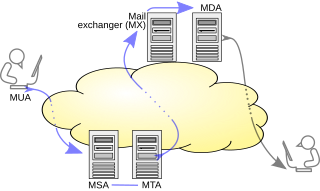Related Research Articles

Electronic mail is a method of exchanging messages ("mail") between people using electronic devices. Email was thus conceived as the electronic (digital) version of, or counterpart to, mail, at a time when "mail" meant only physical mail. Email later became a ubiquitous communication medium, to the point that in current use, an email address is often treated as a basic and necessary part of many processes in business, commerce, government, education, entertainment, and other spheres of daily life in most countries.
The Simple Mail Transfer Protocol (SMTP) is an Internet standard communication protocol for electronic mail transmission. Mail servers and other message transfer agents use SMTP to send and receive mail messages. User-level email clients typically use SMTP only for sending messages to a mail server for relaying, and typically submit outgoing email to the mail server on port 587 or 465 per RFC 8314. For retrieving messages, IMAP is standard, but proprietary servers also often implement proprietary protocols, e.g., Exchange ActiveSync.

Sendmail is a general purpose internetwork email routing facility that supports many kinds of mail-transfer and delivery methods, including the Simple Mail Transfer Protocol (SMTP) used for email transport over the Internet.
A Domain Name System blocklist, Domain Name System-based blackhole list, Domain Name System blacklist (DNSBL) or real-time blackhole list (RBL) is a service for operation of mail servers to perform a check via a Domain Name System (DNS) query whether a sending host's IP address is blacklisted for email spam. Most mail server software can be configured to check such lists, typically rejecting or flagging messages from such sites.

Exim is a mail transfer agent (MTA) used on Unix-like operating systems. Exim is free software distributed under the terms of the GNU General Public License, and it aims to be a general and flexible mailer with extensive facilities for checking incoming e-mail.
qmail is a mail transfer agent (MTA) that runs on Unix. It was written, starting December 1995, by Daniel J. Bernstein as a more secure replacement for the popular Sendmail program. Originally license-free software, qmail's source code was later dedicated in the public domain by the author.
A message delivery agent (MDA), or mail delivery agent, is a computer software component that is responsible for the delivery of e-mail messages to a local recipient's mailbox. It is also called a local delivery agent (LDA).

In computer terminology, a honeypot is a computer security mechanism set to detect, deflect, or, in some manner, counteract attempts at unauthorized use of information systems. Generally, a honeypot consists of data that appears to be a legitimate part of the site which contains information or resources of value to attackers. It is actually isolated, monitored, and capable of blocking or analyzing the attackers. This is similar to police sting operations, colloquially known as "baiting" a suspect.
Various anti-spam techniques are used to prevent email spam.
Greylisting is a method of defending e-mail users against spam. A mail transfer agent (MTA) using greylisting will "temporarily reject" any email from a sender it does not recognize. If the mail is legitimate, the originating server will try again after a delay, and if sufficient time has elapsed, the email will be accepted.
Milter is an extension to the widely used open source mail transfer agents (MTA) Sendmail and Postfix. It allows administrators to add mail filters for filtering spam or viruses in the mail-processing chain. In the language of the art, "milter" refers to the protocol and API implementing the service, while "a milter" has come to refer to a filter application that uses milter to provide service.
Email filtering is the processing of email to organize it according to specified criteria. The term can apply to the intervention of human intelligence, but most often refers to the automatic processing of messages at an SMTP server, possibly applying anti-spam techniques. Filtering can be applied to incoming emails as well as to outgoing ones.

A message submission agent (MSA), or mail submission agent, is a computer program or software agent that receives electronic mail messages from a mail user agent (MUA) and cooperates with a mail transfer agent (MTA) for delivery of the mail. It uses ESMTP, a variant of the Simple Mail Transfer Protocol (SMTP), as specified in RFC 6409.
Email harvesting or scraping is the process of obtaining lists of email addresses using various methods. Typically these are then used for bulk email or spam.

MIMEDefang is a GPL licensed framework for filtering e-mail. It uses sendmail's "Milter" API, some C glue code, and some Perl code to let the user write high-performance mail filters in Perl.
Brightmail Inc. was a San Francisco-based technology company focused on anti-spam filtering. Brightmail's system has a three-pronged approach to stopping spam, the Probe Network is a massive number of e-mail addresses established for the sole purpose of receiving spam. The Brightmail Logistics and Operations Center (BLOC) evaluates newly detected spam and issues rules for ISPs. The third approach is the Spam Wall, a filtering engine that identifies and screens out spam based on the updates from the BLOC.
Since Internet users and system administrators have deployed a vast array of techniques to block, filter, or otherwise banish spam from users' mailboxes and almost all Internet service providers forbid the use of their services to send spam or to operate spam-support services, special techniques are employed to deliver spam emails. Both commercial firms and volunteers run subscriber services dedicated to blocking or filtering spam.

An e-mail agent is a program that is part of the e-mail infrastructure, from composition by sender, to transfer across the network, to viewing by recipient. The best-known are message user agents and message transfer agents, but finer divisions exist.
People tend to be much less bothered by spam slipping through filters into their mail box, than having desired e-mail ("ham") blocked. Trying to balance false negatives vs false positives is critical for a successful anti-spam system. As servers are not able to block all spam there are some tools for individual users to help control over this balance.

Sendmail, Inc. is an email management business.
References
- ↑ Claudio Correlli and David Kennedy (2005). Ubiquitous Services and Applications. Margret Schneider. ISBN 3-8007-2891-5. - By European Institute for Research and Strategic Studies in Telecommunications.